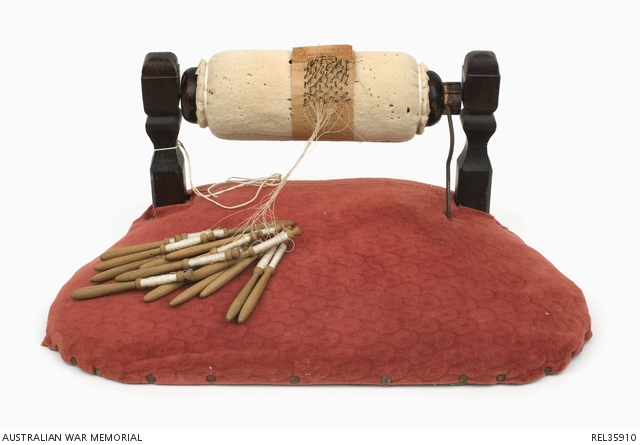| Place | Europe: France |
|---|---|
| Accession Number | REL35910 |
| Collection type | Heraldry |
| Object type | Heraldry |
| Physical description | Wood |
| Maker |
Unknown |
| Date made | c 1914-1919 |
| Conflict |
Period 1910-1919 First World War, 1914-1918 |
French style lace pillow : Sergeant H L Brunskill, 5 Division Mechanical Transport Company, AIF

French pillow for lace making. The pillow is made of padded red patterned velveteen held in place on a wooden base with metal tacks.The padded bolster, mounted on a wooden frame, is covered in cream felt held in place at each end by cotton ties. A lace pricking parchment for plain hole ground lace is attached around the centre of the bolster. A small amount of lace, made with eight pairs of bobbins, is attached to the parchment. A metal arm extending from the pillow can be slotted into holes in the wooden cross piece holding the bolster to prevent it rotating while lace making is in progress.
Lace pillow associated with the service of 13182 Sergeant Herbert Lancaster Brunskill, who was born at Wagga Wagga, New South Wales. A motor driver by profession, he was nearly 22 when he enlisted in the AIF on 29 August 1916. He was promoted to sergeant on 24 October. Brunskill embarked for overseas service at Melbourne on board HMAT Persic, on 22 December 1916, with the Headquarters section of 2 Auxiliary Mechanical Transport Company. He arrived in Devonport, England on 3 March 1917. He arrived in France on 21 June 1917 with 5 Division Motor Supply Column, where he served the remainder of the war, excluding a period of leave in England in March 1918. While on leave he was transferred to 5 Division Mechanical Transport Company. He was severely reprimanded on 30 April 1919 for joy riding in a War Department vehicle on the evening of the 29 April. He returned to Australia on board HMAT Ulysses September 1919.This lace making pillow and the accompanying equipment was brought back to Australia by Sergeant Brunskill for his fiancée, Isabella Houston, who he married in 1921. The lace pillow is of the French style, with a rotating bolster attached to the pillow. French pillows are good for making thin edging laces as the lace maker can set up the pricking around the bolster and continue working as it rotates. A brake on the front left of the bolster kept it static while a section of the lace was being worked. The piece of lace being worked on this pillow is plain hole ground lace, a simple design, requiring only eight pairs of bobbins. The pillow was donated with lace prickings and extra bobbins (see REL36194-96). The lace prickings are designs for a type of lace known as Torchon lace, a bobbin made lace, also called ‘beggar’s lace’ because it was made and sold by European peasants. It is simple to make in comparison to other lace styles. The bobbins with this lace pillow are also of the French style and are wound with linen thread. In lace making the bobbins must all be of the same type and a similar weight to maintain the tension of the thread and the shape of the lace.